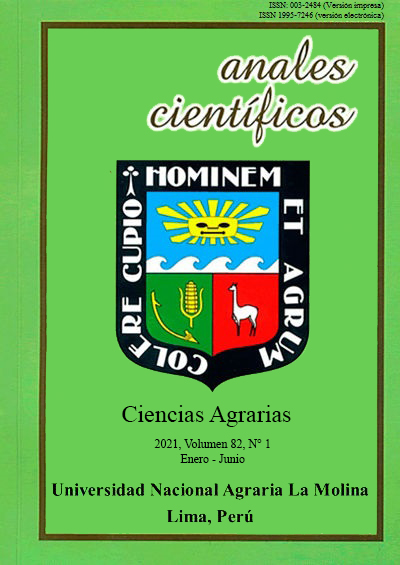The histopathological findings, etiology and prevalence of the dandruff" in vicuñas (Vicugna vicugna mensalis) in the buffer zones of the Pampa Galeras National Reserve
DOI:
https://doi.org/10.21704/ac.v82i1.1751Keywords:
Dandruff, Vicugna, Pampa GalerasAbstract
The objective of this study was to recognize the histopathological findings, to identify the possible agent etiological and to determine the prevalence of the “dandruff" in vicuñas (Vicugna vicugna mensalis) in the buffer zones of the Pampa Galeras National Reserve Bárbara D’achille in Lucanas Rural Community– Ayacucho. Biopsies were taken from the rib region of sixty vicuñas among males and females, ages of youth and adults, which presented “dandruff” in a initial level, obtained from a total of 842 captures vicuñas. The samples were placed in 10% formalin, then were processed by the paraffin inclusion technique and coloured with H. - E., Gram coloration and PAS coloration. The results indicated that the prevalence rate of the dandruff in vicuñas was 9.03%; the most affected population was adult females (13,9%), young female (13,2%) and young male (8,2%). All the skin samples had hyperkeratosis in the córneous layer with parakeratosis (86,7%) and orthokeratosis (13,3%); also, was found the presence of acanthosis in the germinative layer of the epidermis. There was no evidence of fungal infections, parasites and/or bacteria. The histopathological results were compatible with nutritional deficient such as protein, fatty acids, vitamin A, zinc and copper. The most affected group was the vicuñas with the most nutritional requirements, such as vicuñas in growing and reproductive states. These results suggest that over grazzing native pasture is not enough to cover the nutritional requirements of these animals.
Downloads
References
• Alzola, R. (2002). Guía de estudio: Sistema Tegumentario. Curso de Histología, Embriología y Teratología. UNCPBA. Facultad de Ciencias Veterinarias. Argentina 3-12 p.
• Alzola, R. (2001). Guía de estudio: Técnicas histológicas. Curso de Histología, Embriología y Teratología (en línea). UNCPBA. Facultad de Ciencias Veterinarias. Departamento de Ciencias Biológicas, Argentina. Disponible en [18/09/2021]. http://www.slideshare.net/JoseMoi/tecnicashistológicas-11877628.
• Bustinza, A.V. (2001). La alpaca, conocimiento del gran potencial andino. 1ra Ed. Oficina de recursos del aprendizaje – Sección publicaciones – UNA, Puno.
• Brack, A. (2010). La vicuña. Perú Ecológico. Disponible en [18/09/2021]. http://www.peruecologico.com.pe/econeg_vicuna_masinfo.htm.
• CONACS. (2007). Ex Consejo Nacional de Camélidos Sudamericanos. Boletín Informativo Institucional 2007. Ministerio de Agricultura. Lima - Perú. 46p.
• Cotrina, V. (2009). Informe de la problemática de la “caspa” en vicuñas. Comunidad Campesina de Lucanas-Ayacucho. 30p.
• Gázquez, O.A. (1991). Patología Veterinaria 1ra ed. Editorial McGraw-Hill-Interamericana de España. 365 p.
• Jenkins, K., & Kramer G. (1989). Influence of excess dietery copper on lipid compositions of calf tissues, J. Dairy Sci. 72, 2582-2591.
• Jubb, K.V., Kennedy, C., & Palmer, N. (1990). Patología de los Animales Domésticos Tomo 1, 3ra. Edición. Editorial Agropecuaria Hemisferio Sur. Montevideo-Buenos Aires. 529 p.
• Junqueira, L., & Carneiro, J. (2000). Histología básica. Masson S.A. España. 489 p.
• Lacolla, D.V., García, M.G., Hernández, C., & Von Lawzewitsch, I. (2001). Sistema tegumentario de la vicuña (Vicugna vicugna). Histología. Facultad de. Ciencia Veterinarias. UNL Pam. Gral. Pico. La Pampa. 15-21p.
• Mc. Dowell, L. (1992). Minerals in Animal and Human Nutrition. Academic Press Inc. USA. 524 p.
• Mc. Dowell, L. (1989). Vitamins in Animal Nutrition. Academic Press Inc. USA. 486 p.
• Palomino, M. (2001). Fisiología de la piel. Revista Peruana de Dermatología. 11(2). Disponible en [18/09/2021]. https://sisbib.unmsm.edu.pe/bvrevistas/dermatologia/v11_n2/fisio_piel.htm
• Radostits, O., Gay, C., Blood, D., & Hinchcliff, K. (2000). Medicina Veterinaria. Tratado de las enfermedades del ganado bovino, ovino, porcino, caprino y equino. Editorial Mc Graw Hill, Novena edición, Saskatoon-Canada. 1841, 1843 pp.
• Rodríguez, A. (1985). ¿Qué es el cuero? Curso sobre curtido al cromo. CIATEG- México.
• Trejo, W. (2013). Tecnología de cuero. Guía de práctica. Facultad de Zootecnia. Universidad Nacional Agraria La Molina. Perú. 60p.
Downloads
Published
Issue
Section
License
Copyright (c) 2021 María Flores, Wilder Trejo, Gloria Palacios

This work is licensed under a Creative Commons Attribution 4.0 International License.






